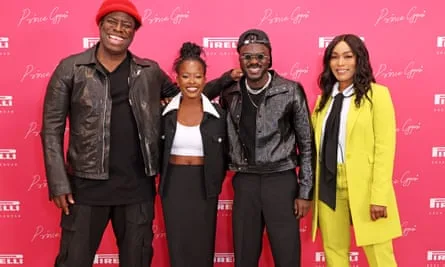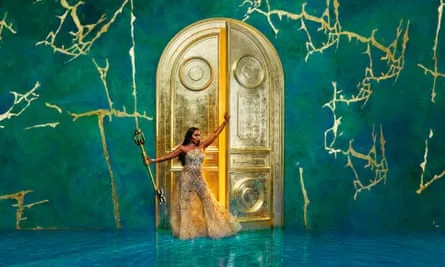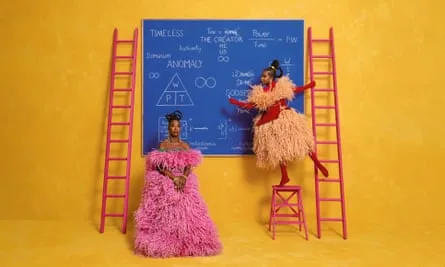The annual Pirelli calendar has been shot by a black photographer for the first time since its launch in 1964.
The 28-year-old Ghanaian visual artist Prince Gyasi was in LA when he first got the call from the Italian tyre company asking him to fly to New York for a “vibe check”.
Vibe checked, he got the job. The fact that he is the first black artist, and the first African, to shoot the calendar means a lot to him. “It’s about opening the door, opening the floodgate,” he said at a launch event in London on Wednesday.
“If I open it and I close the door there’s no reason for me being the first artist to do that. It’s about what happens after, does it continue … It’s not just about having the title … for me it’s about other people being able to touch that opportunity.”
The theme of this year’s calendar is timelessness, which is represented perhaps most literally through a shot of the evergreen Naomi Campbell standing in front of a melting, Dali-esque clock. Other names that Gyasi chose to shoot included the actor Idris Elba, the singer and actor Teyana Taylor, the footballer Marcel Desailly, the painter Amoako Boafo, and King Otumfuo Osei Tutu II of Ghana.

Amanda Gorman, the youngest inaugural poet in US history, is also featured. She is up a ladder writing equations on a blackboard, next to which stands Margot Lee Shetterly, the author of Hidden Figures: The Untold Story of the African American Women Who Helped Win the Space Race.
The photo, says Gorman, “is directly acknowledging that I stand on the shoulder of so many other people … it says that I was able to rise to where I am today because of people like her”.
The actor Angela Bassett is photographed in front of a huge door. “I think it’s glorious,” she says of her portrait. “This by far is the most beautiful shot and set that I’ve been a part of … this is exciting, a young man from Africa … he’s at the beginning of his career and he’s already a visionary. That adds to what makes it so special.”




Pirelli in recent times has embarked on a rebranding that has been nothing short of a total overhaul. It began with the famous photographer Annie Leibovitz being invited to shoot the 2016 edition, which featured pictures of clothed “sheroes” such as Yoko Ono and Serena Williams. For 2017, an unretouched Dame Helen Mirren was December, shot wrapped in a blanket, and a similarly unretouched Uma Thurman wore a polo neck. The 2018 calendar featured an all-black group of models, activists and actors shot by Tim Walker.
It is very different from the Pirellis of yore, which often featured women in no or next to no clothes, shot through the lens of the “male gaze”. Most on-the-nose, perhaps, was the 2010 calendar, shot by Terry Richardson, whose name has since become something of a byword for female exploitation in the fashion industry, with young models photographed eating bananas and pretending to eat cockerels.
after newsletter promotion
Gyasi says he came to the brand not through the calendars and their chequered past, but through Formula One. “I have a car, so I use the tyres,” he says. “My favourite rapper name-dropped Pirelli in his debut album. I watch sports every day so that’s where I know Pirelli from, I don’t know other things. I don’t do politics.”
The calendar, or “The Cal” as it is trademarked, isn’t available to buy. Part of its personal lore is that it is reserved for people the company deems big cheeses – key clients and VIPs. But despite this, it holds cultural capital. As Gorman put it to the New York Times recently: “It still matters.”




Speaking in London yesterday, she explained further: “in a world that is still incredibly digital and visual and imagery – based, being able to create images and representations of people is still such a cultural power to have, regardless if it’s a tyre company, a social media influencer or a poet.
“That type of, let’s say, authority over the images that enter the cultural space is astronomical. And so the idea that this institution is creating a calendar where the gaze is African … and where the talent is African or Black … I think that matters and shows our image matters and shows our lives matter.”

